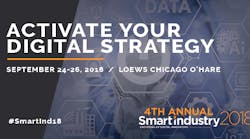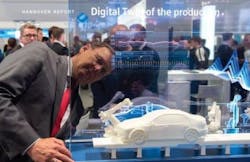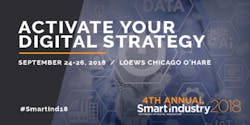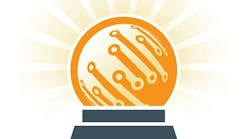Digitalization's toolkit on display at Hannover
By Keith Larson, Smart Industry editor in chief
Ever since Germany staked out its national vision of Industrie 4.0—the ongoing digitalization of manufacturing substantial and far-reaching enough to constitute a fourth industrial revolution—the displays at Hannover Messe, Germany’s largest industrial trade fair, have served as an annual progress report on the global uptake of transformative new digital technologies and business models.I count myself fortunate to have been among the more than 200,000 delegates to visit in April the nearly 6,000 exhibitor stands from companies around the world spread across the sprawling fairground campus on the outskirts of Hannover. Doing justice to the full scope of Hannover does indeed beggar the imagination, so I focused much of my visit on researching some of the latest developments in information systems, automation and connectivity technologies. (As if that weren’t enough.)
Reassuringly, an increasing number of technology suppliers put their main exhibit focus on stories of how their customers were realizing real returns on technology implementations. In terms of enabling technologies, some of the key technology trends and focus areas included security and networking; edge and cloud compute (and where to draw the line); and all aspects of non-human smarts: machine learning, deep learning and other shades of artificial intelligence.
Security & networking
If seeking to understand how IT networking technologies continue to be adapted to the needs of industrial, or operational technology (OT), environments, a visit to Cisco’s Hannover stand was a great place to start. In the industrial space, Cisco is aiming to “replace inefficiencies with information,” according to Bryan Tantzen, general manager of Cisco’s Connected Industry and Manufacturing business unit.
To accomplish this task, the company has set its sights on three essential problems: security, complexity and data management. On the security front, the company now offers a range of security technologies specifically set up for industrial networks, including its Identity Services Engine and StealthWatch security visibility and analytics. This is significant, because in the past these services stopped at the switch/router level but can now reach down to individual networked devices such as programmable logic controllers (PLCs) on industrial Ethernet networks.
Cisco is tackling complexity by bringing “network automation into the factory automation space,” Tantzen continued. Indeed, the company’s Industrial Network Director is specifically designed to help operations teams manage automation environments by providing full visibility and control of industrial Ethernet infrastructure in the context of automation processes.
Finally, in the realm of data management, Cisco’s Kinetic Data platform goes quite a ways beyond mere networking, with the ability to extract and normalize data from devices on distributed networks, apply rules to “data in motion” for fast decision-making and data reduction, and move data among multiple locations where apps reside—all the while enforcing policies around data ownership privacy and security. “We’re connecting, extracting and prepping data for edge compute integrations with the likes of Telit, Kepware and IBM Watson applications,” Tantzen said.
Another hot topic of discussion at Hannover—and one in which Cisco has an interest—is the proposed use of the OPC UA data model standard in conjunction with time-sensitive networking (TSN) extensions to standard Ethernet to effectively replace the variety of proprietary industrial network that have developed over the years to overcome the deterministic limitations of Ethernet. In a separate press conference at Hannover, Tom Burke, president and executive director of the OPC Foundation announced that a stable OPC/TSN draft standard had been completed, and that “prototyping is underway.”The success or failure of these sorts of standards efforts seldom hinges on technical merit, but often depends on political alliances among the supplier community. In yet another Hannover announcement, key player Rockwell Automation announced that it would join a group called “the Shapers” whose goal is to create a communication solution for real-time and sensor-to-cloud applications in industrial operations “based on the OPC UA protocol, which allows easy and secure sharing of information across different vendor technologies and the time-sensitive networking (TSN) suite of standards, which helps improve latency and robustness in converged industrial networks,” the company said in a statement.
“Connecting technologies across an industrial organization while maintaining multivendor interoperability requires a harmonized, interoperable solution that uses consistent information models, communication and application behavior (together known as application profiles),” said Paul Brooks, business development manager, Rockwell Automation.
Other industrial infrastructure companies already pledging support to the movement are ABB, Belden, Bosch Rexroth, B&R, Cisco, Hilscher, KUKA, National Instruments, Parker Hannifin, Phoenix Contact, Pilz, Schneider Electric, TTTech and WAGO.
Time will tell whether OPC/TSN ultimately supersedes the current landscape of alternative approaches, but a unified Ethernet standard that passes muster for the entire OT stack is certainly a compelling step toward the long promised land of device-level multivendor interoperability.
Edge & cloud compute
The rise of cloud computing has essentially reduced the old multi-layered automation/information architecture models and nomenclature to two levels: the cloud and the edge. Some advocate for “fog” rather than edge—an appropriately vague boundary line, since virtualization is now used extensively in both places, and increasingly scalable solutions can readily be deployed in the cloud, on-premise or in some hybrid configuration.
Oracle, on the one hand, finds that most of its customers are pursuing a “cloud first” approach: whatever can be moved to cloud, should be. The dynamics governing that decision include the multiplicity of sources of information across quality, supply chain and other industrial domains. Also, there’s the integration of multiple functional systems such as a computerized maintenance management system (CMMS) with the automatic ordering of a replacement part. “In the cloud,” notes Lionel Chocron, Oracle’s VP of industry and IoT solutions, “it’s much easier to create application bundles to get things done.”
The company is working to create applications that provide a straight line to business benefits, including its new Connected Assets, Connected Production, and Adaptive Intelligent Apps for Manufacturing, which were front and center at Hannover. “It’s important to remember that the edge is complex,” Chacrone added. “Do what you need to do there, but leverage the cloud for everything else.”
But for those applications that do demand robust, enterprise-class local computing, ABB, Hewlett Packard Enterprise (HPE) and Rittal together unveiled the Secure Edge Data Center (SEDC), a turnkey, micro-modular datacenter that is purpose-built for rough environments. The SEDC was designed to allow customers to run enterprise-grade IT in close proximity to their OT environments, machines and equipment to enable low-latency, secure and reliable digital processes.
The SEDC significantly simplifies the deployment of enterprise-grade IT solutions in industrial environments regardless of their location. The turnkey solution can be quickly commissioned; resists humidity, dust and dirt; includes fire suppression and back-up power; and can be remotely monitored and managed. Further, by equipping the SEDC with hybrid platforms such as HPE ProLiant for Microsoft Azure Stack, customers can deploy Azure-consistent applications to their preferred location—on HPE infrastructure in the SEDC or a data center, as well as in the Microsoft Azure public cloud—to meet their specific requirements regarding performance, security or cross-site collaboration.
As the world’s leading industrial automation supplier—and “home team” for the many attendees from across Germany—Siemens casts a wide shadow at Hannover. And I’m not talking just about the biggest-in-show, three-level booth either. Indeed, it would be impossible in this small space to do justice to the full range of Siemens solutions that stands ready to automate and integrate nearly every function required to bring products from idea to reality—so I’ll not try.
Instead, let me draw attention to Siemens’ increasingly scalable approach to digitalization that embraces the company’s heritage at the edge with expanding capabilities in the cloud. At Hannover Messe, for example, the company presented a future-oriented expansion of data-driven applications called the Siemens Industrial Edge concept. It’s an edge-computing variation on the company’s cloud-based “IoT operating system” called MindSphere that enables users to take advantage of the platform’s extended functionality and greater performance on site, while maintaining full control over data.
Easier ML, DL & AI
Whether called machine learning (ML), deep learning (DL) or simply artificial intelligence (AI), software applications with the ability to recognize patterns then take some action based on that recognition—and in doing so, relieve their human masters of repetitive drudgery—seems an obvious evolution of the data analytics journey we’ve been on for some years now.
PricewaterhouseCoopers predicts the global GDP to grow 14%—the equivalent of $15.7 trillion—by 2030 as a result of AI, with increased labor productivity and consumer demand being the most impactful business outcomes. However, while AI holds great promise, current adoption rates are low. According to Gartner’s 2018 CIO Agenda Survey, 4% of CIOs globally have implemented AI, while a further 46% have developed plans to do so.
To help accelerate adoption, HPE showcased at Hannover Messe a range of new offerings intended to help customers ramp up, optimize and scale AI usage across business functions to drive outcomes such as better demand forecasting, improved operational efficiency and increased sales.
HPE Digital Prescriptive Maintenance Services is the first in a series of AI-enabled industry offerings from HPE Pointnext, and automates problem prevention and increases productivity of industrial equipment. The HPE Artificial Intelligence Transformation Workshop leverages the consulting expertise from HPE Pointnext to help customers get started with AI, evolve their strategic data and analytics initiatives and prioritize AI use cases. And the HPE Apollo 6500 Gen10 System is a next-generation, high-performance computing system purpose-built for deep learning that delivers 3x faster model training than previous generations.
While perhaps not technically an example of AI, Beckhoff Automation’s addition of voice and language recognition capabilities to its TwinCAT automation software certainly represents a personification of technology, much in line with personal assistants Siri and Alexa we may encounter in our private lives.
TwinCAT Speech allows multilingual input and output of queries or information in line with industry standards. This enables interaction with the automation system to be carried out much more efficiently and conveniently. The technology can be applied across numerous industries in a wide range of applications from machine design to building automation. When working on a machine component, for instance, operation and maintenance personnel can simply inquire about the impact of changed settings on the current control or simulation application without having to use a conventional operator interface. In addition, appropriate alarm messages can be given out acoustically when critical system values are reached.
Speech input is available as an offline function and is implemented on the basis of built-in Windows operating system functionalities. In other words, it is accomplished without requiring an Internet or cloud connection. Speech output from TwinCAT Speech is available both as an offline function and an online function.
In the case of offline, support is provided by the appropriate Windows functionalities and in online cases via Polly, the text-to-speech service from Amazon. The realistic sounding speech output for these applications is synthesized with the aid of deep learning technologies. Multiple voices can be supported in addition to the caching of audio files generated online.
Even if it’s not strictly AI, it still makes me want to ask: “Hans, when do we know it’s time to start working on Industry 5.0?”





